The search for Bonnie and the Little Boys Blue felt for many years like chasing down the Loch Ness monster. This legendary vocal group from Lexington’s past had achieved almost mythical status in the vinyl community during the collecting heyday of the genre. But unlike Scotland’s Nessie, they were actually known to have existed! It took me many years to locate some members (which I was able to do in the very early 2000s), but memories of those early years were already fading. There is much I wish I could add and certainly it is subject to future correction, but given this late date…this is probably the most complete tale that will ever be told… enjoy! [2021 Shawn Chambers / Lexingtunes]
When we played… it was the place to be! Might be the Boys fronting for the Pacesetters or the Houserockers. Little Orbit might be singing, too. Sometimes they’d send one of them King [label] fellas down to headline. If you didn’t hear it that night, you sure heard about what you missed the next morning! – “Red” George
The roots of Bonnie and the Little Boys Blue can be traced back to the Lexington’s original Paul Laurence Dunbar and Frederick Douglass High Schools where friends and former classmates came together to form one of central Kentucky’s greatest vocal groups.
Robert Taylor “Red” George (b. 1940) a star Dunbar football halfback teamed with Ronnie West and tenor Charles Barbour Jr (b. 1940), but it took the addition of a couple young ladies in Bonnie Johnson and Mary Evans before they found the golden sound that still delights record collectors some sixty years later.
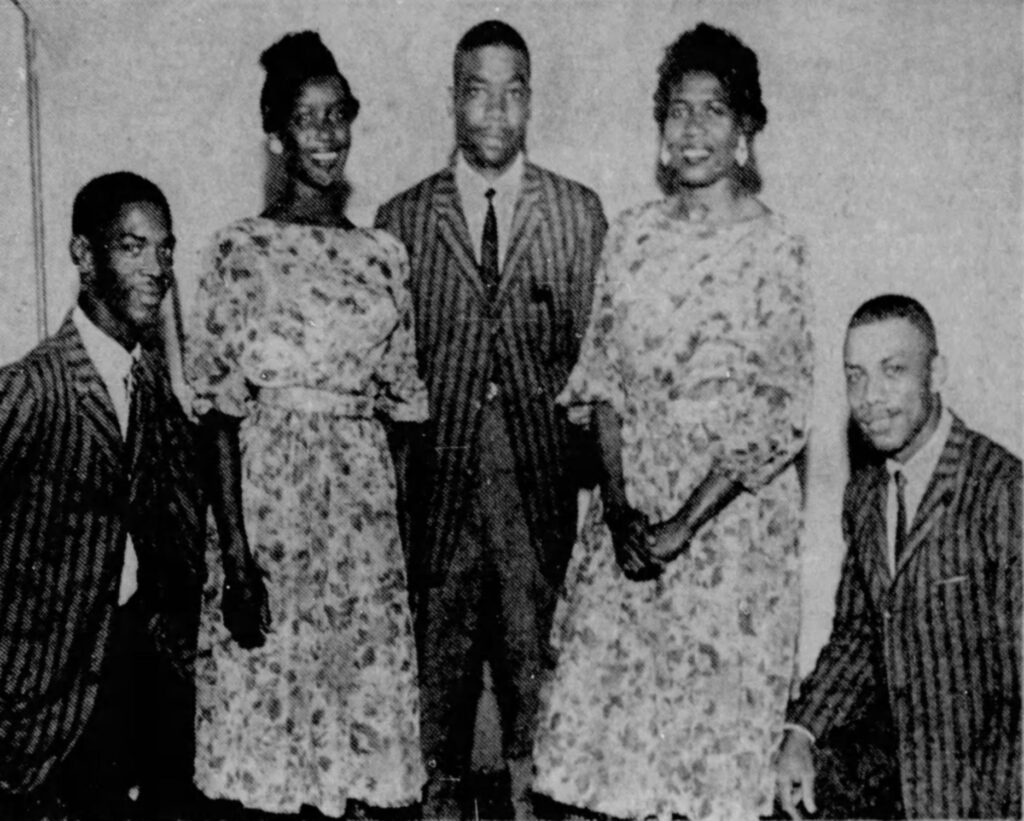
“Red” George, Bonnie and another friend (Emmett Brown) had experience singing on street corners downtown, which preceded the true formation of the group. Also, at least two future Blue Boys had prior recording experience backing Bruce Marvello on label owner Tom Birch’s original composition “Teen-Age Broken Heart.” Clearly their voices made an impression on Birch and he approached the quintet with an offer of a recording contract.
Given Clyde Thomas Birch’s lack of success with his first attempt in reluctant teen idol Marvello it would be understandable if he were more gun shy this second time around, but the reality was he chose to go even bigger. In many ways Birch had promotion in his blood.
Tom Birch’s first foray into showbiz was as a circus clown for the Daly Brothers, which then segued into working for a traveling horror show and as a comedian. In the mid 50s, Birch served a stint in the Air Force and traveled the world performing in their “Tops In Blue” show as well as hosting his own variety show in his spare time.
Back in the Bluegrass, Birch split work between his day job working for the newspaper, his weekly WLEX TV dance show, as well as handling promotional work for clubs and restaurants. Seemingly, his personality split along with the workload as he could be found under the pseudonyms Nick Martino and Nick Birch for his various attempts at a Theatrical & Modeling Agency and as a talent scout.
Like all good promoters, Birch exuded confidence and perhaps a bit of hucksterism. In the Dark Ages before social media he possessed a certain consciousness of image with one young neighbor recalling how “he always wore a suit on his bus ride to the Herald [newspaper] and packed his ink-stained work shirts in a satchel. Then he would change at work so folks wouldn’t see him in his day uniform.”
In more modern parlance it might be easy to call out Tom Birch as just another member of the “fake it till you make it” crowd, but this would be unjust as his “deceptions” and use of pseudonyms were always backed by real actions and countless hours of work – although with never quite enough in the kitty to quit his daily grind at the Herald.
Big voices meet a big personality with bigger promises and at least initially Birch delivered.
His low budget approach to promoting Marvello would not work here. Lugging a handsome teen in front of a group of teen girls was simple, cheap and acceptable. Promoting a black vocal group in 1960s Lexington to a wide audience was going to be a far trickier venture that would require real capital from outside investors.
Tom arranged for a party of financial backers to gather at a Leestown Road steakhouse where Bonnie and the crew aced a live audition. Eschewing any local recording studios, which admittedly were in their infancy, the band was delivered to an unknown studio on Division Street in Nashville, Tennessee. Here a group of seasoned (but unknown) studio musicians would provide the backing for tracks that day.
The tagged A-side “Bells” was an obvious attempt at something radio friendly with a fairly traditional vocal sound at the onset, but Bonnie continues to build and build her voice until it reaches a much more rhythm n’ blues climax over the smooth doo wop backing track and simple instrumentation.
Today, it is the flip that gets the vast majority of attention and rightfully so – it is nothing short of a party on vinyl. “You’d Better Run” starts off with a classic doo wop vocal riff but immediately sets a quicker tempo than “Bells.” Bonnie’s voice is strong and fine and playfully admonishes:
If you don’t run I will get you under my spell
And under that spell I’ll make you love me
Whoa Ooh Ooh Ooh
Run! Before it’s too late
My love just won’t wait – you’d better run
Add a blistering sax solo punctuated by the Boys’ exclamations and in no time the lucky listeners are kicking off their shoes and moving the furniture for a dance party!
As always with Birch, it may have been a party in the studio but business once the doors closed. Just as he had on the Marvello release, Birch received at least a partial writing credit on both sides along with Bonnie and Ron West. At this late date his contribution to the material is completely unknown, but the group was known to do their own arrangements and writing according to at least one contemporary source so his addition was likely minimal and financially motivated.
The conquering heroes returned to Lexington and awaited the final mastering and pressing of the single.
Birch was aware enough the second time around to practice a bit of geographic obfuscation by removing his Lexington address from the 45’s label. This simple change would certainly cut down on any preconceived notions that any large city DJ might otherwise form prior to even sampling the great cuts that Bonnie Johnson and crew laid down. It is unknown if it helped but an independent record label needs to play any angle that might give him an edge.
Certainly what didn’t do the group any favors was Billboard Magazine. Oh, the review was kind enough with the squares there gifting the soft “Bells” three stars and noting that “Bonnie gets some interesting vocal effects.” Obviously, the rocker would be too much for them and “You’d Better Run” was two-starred. This was surprisingly generous given the industry mag’s history of down voting small labels. What was more surprising was it was reviewed inexplicably under the Country & Western category! The placement of the column was directly adjacent to the Rhythm N’ Blues reviews so it may have been a simple editing room mistake. One can only imagine the face of a young Oklahoma C&W deejay giving it a listen…
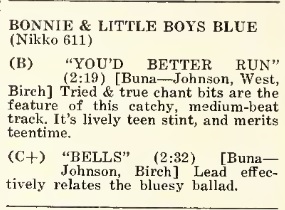
The number pressed was seemingly more than the Marvello single with at least one contemporary report quoting Birch as reporting it has “sold 10,000 copies in the first two weeks of nationwide circulation” – almost certainly a bit of hyperbole on the part of Birch. Given the absolute scarcity of the single (not just in the region but elsewhere as well) the quantity pressed almost certainly numbered only a small fraction of that figure – possibly as low as one to two thousand at best. Either that or cases of them remain in a rusted-out Studebaker’s trunk parked in a barn somewhere.
Certainly, the single helped launch the group into the Lexington market and shows followed at the predominantly black music clubs like the Pralltown Café, the Georgetown Street VFW, and the Cotton Club, but the band also enjoyed some crossover appeal as expected with bookings at the hot Joyland Casino and elsewhere.
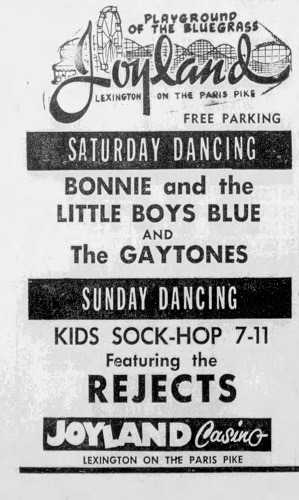 For those that made the shows – what a treat! Great music from the backing band of the Houserockers or Pacesetters was a given with standout musicians throughout both bands’ storied careers. Put beautiful Bonnie Johnson in front with Mary Evans confidently beaming a smile right beside her and the male audience is already hooked. The backing Little Boys Blue of “Red” George, Barbour, and West were equally handsome in their matching jackets and talent – now everyone is on the hook … and THEN they sing and the roof shakes with the applause.
For those that made the shows – what a treat! Great music from the backing band of the Houserockers or Pacesetters was a given with standout musicians throughout both bands’ storied careers. Put beautiful Bonnie Johnson in front with Mary Evans confidently beaming a smile right beside her and the male audience is already hooked. The backing Little Boys Blue of “Red” George, Barbour, and West were equally handsome in their matching jackets and talent – now everyone is on the hook … and THEN they sing and the roof shakes with the applause.
Birch did his best and despite the excellent performances the promotional efforts were still a struggle with adverts sadly usually relegated to the small print of the Colored Notes section of the paper. As the year passed a rift developed and the band parted ways with Birch.
While still under the guidance of Birch, the band was set to record two rhythm n’ blues cuts (“Love Is Everywhere” and “Nursery Rhyme Rock”), but it seems this particular dream died on the vine with the split with Nikko.
The group found a new manager in part owner of the Claughton – Brown funeral home on East Third Street. Harvey D. Brown was well known in the community and had the financial backing to outfit the band with tuxes and evening gowns as well as stylish transportation through his contacts in the funeral business.
Harvey was real good about sometimes getting us a nice town car or a limo for the show. We’d ride along happy…tried not to think about the kind of misery those same wheels might be driving around the next day to the cemetery. – Red George
Brown did arrange for another recording session for the group in Nashville and it was believed to have been fully realized in the mid-60s, but the style and song choices are now lost to memory. Charles Barbour remembered that the material did not get released because Brown got sick and ultimately passed away in July of 1966, thus ending their financial backer. Whether due to Brown’s death or some other forgotten reason – the world was deprived from another effort from Bonnie and the Little Boys Blue.
The band did continue after the death of Brown with some fluidity to the membership. It is known that Harold “Ike” George was involved as was apparently Emmett Brown again at some point. So much is still unknown, but by roughly 1968 the band was no longer together.
Charles Barbour (d. 2020) and Robert “Red” George remained very visible in the church community as members of various gospel chorus groups. The other members remain in the ether, and unfortunately, I was never able to find or truly understand what became of Bonnie Johnson.
Tom Birch moved on to a newspaper job in Houston and passed away in Texas in 1981 at the young age of 45 and well before he could have known how coveted this Nikko release would be to collectors around the world. Thanks to the internet the music has reached a whole new generation of groups keeping the street corner traditions alive with at least one covering Bonnie and the Little Boys Blue material some fifty plus years later.
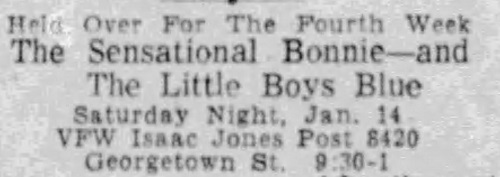
Discography:
Nikko 45 -611 Bells / You’d Better Run 1960
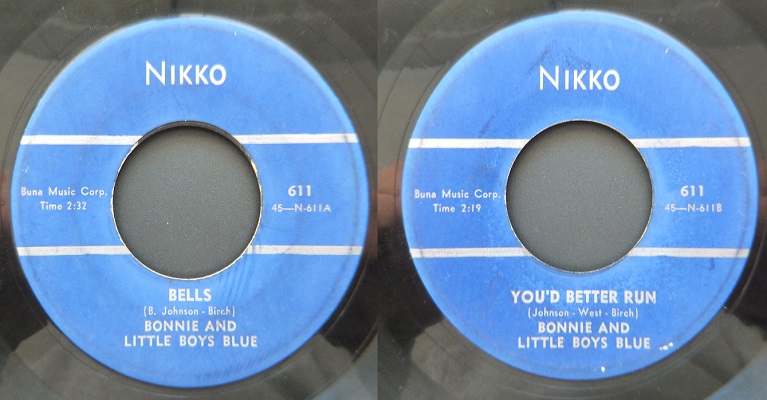
CD:
Doo Wop Undergound – compilation 2007 contains You’d Better Run